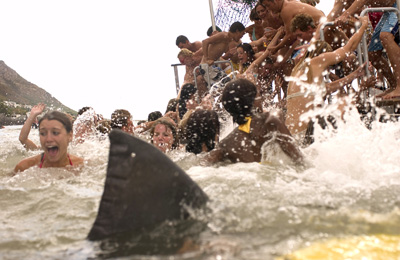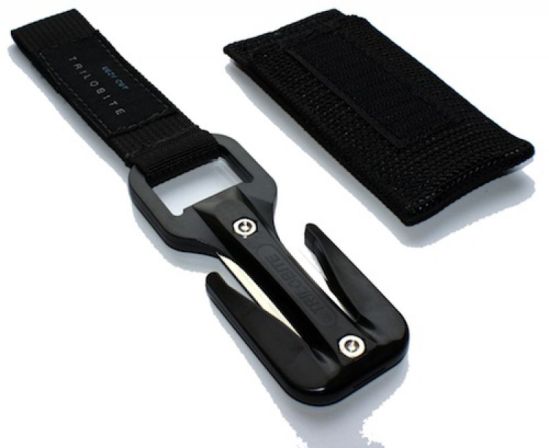Dive knives are probably one of the coolest early purchases that many (mainly male) divers make. If a loved one questions why you need to spend more money on dive gear you can hit them with a guilt trip about entanglement which has them reaching hastily into their purses. Plus most importantly you now have a legitimate reason to own a blade and carry it concealed on your person at all times (that last bit is not true).
However what is the best sort of weapon, I mean cutting tool, to own? Obviously the most exciting one to buy is a machete sized Rambo knife in black with a big serrated edge which you strap onto your leg. Many training agencies with a more military approach to dive training have been big proponents of prominently displayed death stilettos. How strange.
The more modern approach and the one mostly favoured by men who have nothing to prove is that practicality is the most important aspect of your dive shiv and sadly this means smaller knives in less ‘look at how black ops’ I am places. Even more shockingly this sometimes means tools that don’t even look like knives. I know, I know, but please do try to stay with me.
Breadsaw sized knives strapped to an appendage may look cool but in actual fact they can sometimes create an entanglement risk in themselves and that dear reader is as best an example of irony as I could ever hope to come up with.
Smaller knives are easier to handle (although very small knives can become fiddly with thick gloves so don’t go too far down the road of proving how at ease you are with your manliness) and mounting them is much more a case of ease of access. Many smaller knives can be mounted on your BCD, either on the hose or even on the side of the pocket with certain designs. Other knives can be mounted on the webbing of a harness or even just put in a drysuit pocket.
What your knife is made of is also something to consider, stainless steel is the most common choice and the more expensive the knife, the better the quality of the steel. Cheap knives have a tendency to go orange and then not be much good. At the other end of the scale are titanium knives, these don’t corrode and are very light however they are more expensive and also can’t be sharpened (not that you should need to spend large amounts of time sharpening the edges of your knives…)
So the next thing to consider is why you would need to use a knife. The main reason is to fight with the animals of the deep.
As soon as your head is submerged under the water the battle begins, sharks are innately tuned into the sounds of scuba and it drives them into rage fuelled feeding frenzy. Moray eels leave the reef like exocet missiles heading directly for the divers mask. Meanwhile vast shoals of Humboldt squid emerge from the deep intent on stripping the diver to a skeleton in under 30 seconds.
The correct answer is entanglement. This is more likely to be monofilament fishing line (not the stuff from sci-fi movies that cuts people into chunks) and is unlikely to be a foot caught in a giant clam or being enshrouded in kelp. It’s also possible you might need a knife to cut through line from a spool or reel in the event of a premature line explosion and to avoid embarrassment and laughter back on the dive boat.
So is a knife really the best tool for the job? Well a dive knife is a definite must as it can also be used as a tool to measure, pry, dig, cut and pound, (copywrite PADI Open Water Knowledge Review Chapter 2 Question 14) however a line cutter is a great secondary tool and may well be the one you’d reach for first.
A great example of a brilliant little line cutter is the Eezycut trilobite. Since they arrived on the scene we’ve sold loads of them simply because they’re just so good. Check out the video below to see them chopping their way through ever increasing sizes of rope.
They’re also super handy for tec divers as they can be used as a stop on a harness to prevent a pocket sliding forward and also as somewhere to tuck the long hose. OK, they don’t look like cool knives and they do actually come in pink as well, but they’re certainly my primary dive weapon of choice.
So in summary make sure your knife is sharp, easy to use and easy to get to. Then you can just pop it on your kit, forget all about it and go and enjoy your diving safe in the knowledge it will be there should you ever need it.





I’m a girl and I’ve got a dive knife in a sheath that straps to my regs. I carry my regs in my hand luggage when travelling by air to/from a dive holiday. If you do this too…
Top tip 1. Remember to remove said knife from your hand luggage and pack it in your cabin bag (perhaps in your mask box so it doesn’t shred your underwear).
Top tip 2. Try not to do this swap right under the noses of the gun-laden security men at Sharm Airport and other foreign climes – for some reason, they are looking out for sharp objects.
Sage advice!
Learned through experience – could you tell?